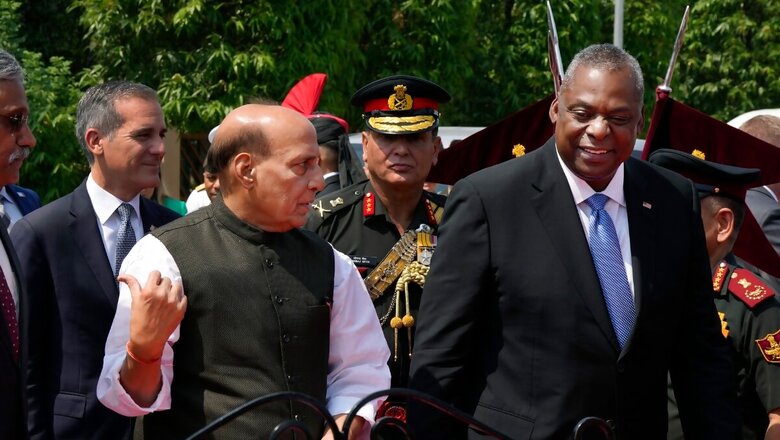
views
US Secretary of Defence General Lloyd Austin visited India on 04 and 05 June in what was his second visit with the aim of reinforcing the major defence partnership and advancing cooperation in critical domains. Significantly, this visit was scheduled ahead of Prime Minister Narendra Modi’s official state visit to the US on June 22. His previous visit to India was in March 2021.
Shortly after landing, Austin tweeted; “I’m returning to India to meet with key leaders for discussions about strengthening our Major Defence Partnership. Together, we’re advancing a shared vision for a free and open Indo-Pacific.”
I’m returning to India to meet with key leaders for discussions about strengthening our Major Defense Partnership.Together, we’re advancing a shared vision for a free and open Indo-Pacific. pic.twitter.com/P73Oy2npDx
— Secretary of Defense Lloyd J. Austin III (@SecDef) June 4, 2023
The Interactions
The Secretary of Defence met Defence Minister Rajnath Singh and National Security Advisor Ajit Doval. During the meetings, they exchanged perspectives on a range of regional security issues. The US committed to collaborating closely with India in support of the shared vision for a free and open Indo-Pacific.
India and the United States also concluded a roadmap for defence industry cooperation for the next few years, the two countries said on Monday, a landmark move expected to bolster New Delhi’s defence manufacturing ambitions.
The US is working to deepen ties with India and sees stronger military-to-military and technology ties as a key counterweight to China’s dominance in the region. It is also seeking to wean India away from its traditional dependence on Russia for defence supplies.
The roadmap was finalised at a meeting between Lloyd Austin and Rajnath Singh. The roadmap is considered significant as Washington maintains strict controls over what domestic military technology can be shared or sold to other countries.
The agreement comes weeks before PM Modi visits Washington for an official state visit to hold talks with US President Joe Biden.
Technology Cooperation
US-India Defence Industrial Cooperation aims at fast-tracking technology cooperation and co-production in areas such as air combat and land mobility systems; intelligence, surveillance, and reconnaissance; munitions; and the undersea domain.
This initiative aims to ‘change the paradigm for cooperation’ between US and Indian defence sectors, including a set of specific proposals that could provide India access to cutting-edge technologies and support India’s defence modernisation plans.
The Indian Defence Minister and US Secretary of Defence also pledged to review regulatory hurdles impeding closer industry-to-industry cooperation and to initiate negotiations on a Security of Supply Arrangement and a Reciprocal Defence Procurement Agreement, which will promote long-term supply chain stability.
India depends on Russia for nearly half its military supplies but has also increasingly diversified its sources to buy from the US, France and Israel, among others. The nation also wants global defence manufacturers to partner with Indian companies and produce arms and military equipment in India for local consumption as well as exports.
The Biden administration is likely to sign a deal that will allow General Electric Co to produce jet engines in India powering Indian military aircraft. Engaging in this level of conversation regarding sharing critical technology is no doubt a pointer regarding both the importance and intensity of the relationship.
New Initiatives
The two sides also discussed the growing importance of defence innovation and cooperation in emerging domains such as space, cyberspace, and Artificial Intelligence. They praised the recent launch of a new Advanced Domains Defence Dialogue and committed to expanding the scope of Bilateral Defence Cooperation to encompass all domains.
The Indo-US Defence Acceleration Ecosystem (INDUS-X), a new initiative to advance cutting-edge technology cooperation, is also been proposed. The initiative, which will be launched by the US-India Business Council on June 21, is designed to complement existing government-to-government collaboration by promoting innovative partnerships between US and Indian companies, investors, start-up accelerators, and academic research institutions.
General Austin and Rajnath Singh also discussed ways to increase information sharing and new initiatives to improve maritime cooperation, including in the undersea domain.
US View
Austin stated that “The US-India Defence partnership matters because we face a rapidly changing world.”
“We see bullying and coercion from the People’s Republic of China, Russian aggression against Ukraine that seeks to redraw borders by force and threatens national sovereignty, as well as transnational challenges such as terrorism, and climate change. So, democracies must now rally together around not just our common interests but also our shared values,” he said.
Keeping this and India’s leading role as a security provider in the Indo-Pacific, Secretary Austin welcomed India’s leadership role in the Quad Indo-Pacific Maritime Domain Awareness Initiative (IPMDA), which aims at providing cutting-edge domain awareness capability to countries across the Indo-Pacific region.
Challenges
There is no doubt that the relationship between the two countries is strong and has been on an upward arc over the past few decades, irrespective of the party in power both in India and the US. However, there are issues that affect the relationship among these, like the US still feels that India is aligned towards Russia and has not supported it in the ongoing conflict in Ukraine.
Their interpretation of the Indo-Pacific does not match. While India defines it to include both the Pacific and Indian Oceans i.e. from the West coast of the US to the East coast of Africa, the US views the Indo- Pacific from the West coast of the US to the shores of India. That could be one of the reasons why Austin met with the Japanese Defence Minister Yasukasu Hamada, Australian Defence Minister Richard Marles and their Philippine counterpart Carlito Galvez in Singapore on the sidelines of the Shangri La Dialogue on June 3, where they talked about the importance of building a networked security architecture in the Indo-Pacific.
India on its part is not ready to join any alliance and retains its strategic sovereignty while the US would like it to be part of an alliance. Pakistan is another issue and there is no doubt that Pakistan has used US funding and military equipment against India in the past and even now, the US has approved funding for spares for the Pakistan F-16 fleet.
The other fact that endures is that countries always place their interests above all else and this is true in the case of the US also. During 1971, they were willing to overlook the genocide in East Pakistan as Nixon and Kissinger were focused on building ties with China using Pakistan as the conduit. More recently, 9/11 changed the priorities, policies and direction of the US and now, despite ‘the stated pivot towards Asia’ to counter the assertiveness of China, the Ukrainian conflict has once again resulted in efforts being directed towards Europe and against Russia. This is a serious inconsistency which affects relationships.
Presently, China is the threat that both countries have to confront and in turn, is binding both nations as regards their security interests. But India sees China in terms of a continental threat in the Himalayas as well as a maritime threat in the Indian Ocean, whereas most US analysts look at the threat from China in terms of the South China Sea and Taiwan Strait.
Conclusion
While both countries are committed to strengthening operational collaboration across all defence domains, the US realises that it needs to support India due to its strategic significance and leading role in the security framework of the Indo-Pacific in view of the expansionism and belligerence of China. India has been the primary security provider and strategic partner to most of its smaller neighbours like Maldives, Mauritius, Seychelles, and Sri Lanka and due to its strategic position, the Indian Navy has always been amongst the first to reach nations requiring humanitarian assistance or medical aid in times of crisis and disasters.
While there is no doubting the centrality of the US-India partnership to maintaining peace and security, the challenge for the US in deepening defence ties also lies in being able to share sensitive defence technology, most of which is developed by private companies. Retaining the essence of these technologies is a ‘delicate dance’.
The author is an Army veteran. The views expressed in this article are those of the author and do not represent the stand of this publication.















Comments
0 comment